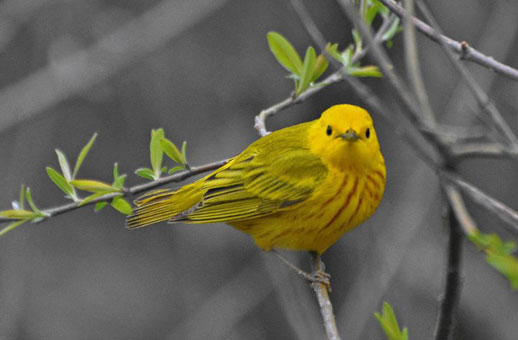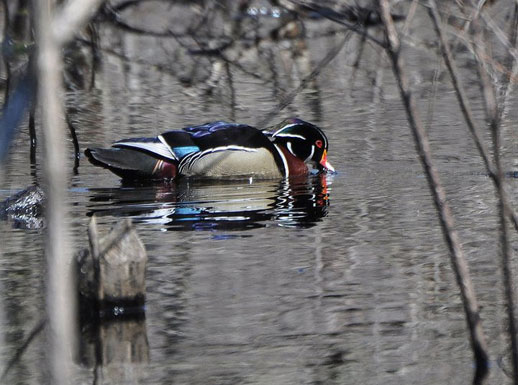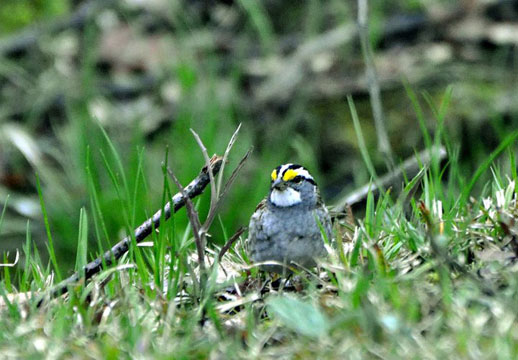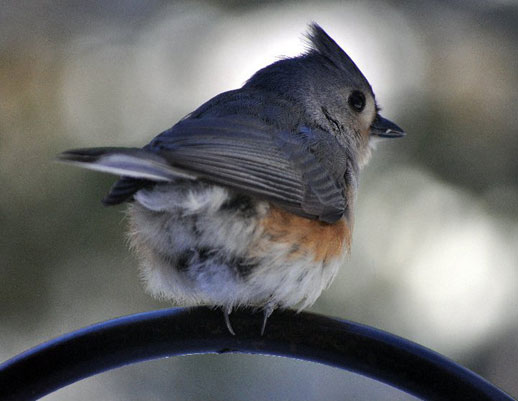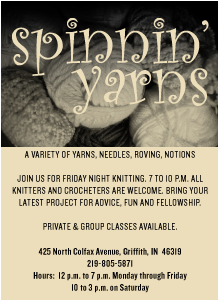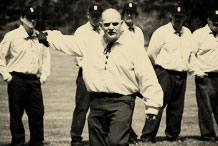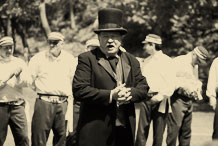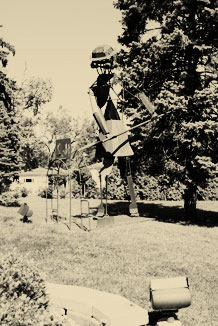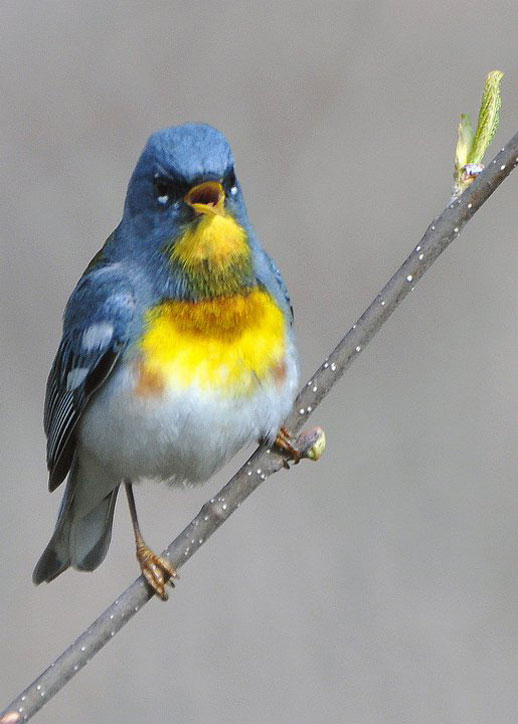
Northern Parula [photo by Brad Bumgardner]

Birdwatching offers delights, eye-opening view of Region
March 8, 2012
Out of all of the hobbies I’ve dabbled in over the past several years, one that has remained near and dear to me is birdwatching. If the photos on this page, all shot in or around The Region, don’t persuade you to consider this pursuit, here are other reasons why you should grab a pair of binoculars and hit The Region’s many nature trails.
NOTE on upcoming workshops: The Lake County Parks’ Gibson Woods in Hammond is hosting a series of workshops on birdwatching starting March 20 at its nature center. The deadline to register is March 11, which is right around the corner. Scroll to the bottom of this piece for more information on the workshops.
The Region’s a hub of activity
I always hear people complain about how flat and boring our landscape is, forgetting that we have dunes, wetlands, forests and prairies right in our backyard. Also, we are situated at the bottom tip of Lake Michigan. Those attributes make us a hub for migratory birds in the spring and the fall, and we also house many species year-round.
(Not so) hidden life of birds
When people think about the birds in our area, cardinals, robins and house sparrows come to mind. That makes sense. Those species visit our feeders and make their homes at eye level in our backyards. When birds sit high in trees, they oftentimes go unnoticed because people simply do not take the time to see what they are.
What many people don’t realize is that our area is home to some incredible species of birds. All sparrows for instance are not created equal. We have field sparrows, grasshopper sparrows, song sparrows and savanna sparrows, to name a few. To the untrained eye, these birds may look quite similar, but a closer look at their field markings tells a different story. Have you ever heard of a blackburnian warbler or a parula warbler, both of which resemble birds of the tropics? In all, 419 species of birds have been found in Indiana—and 366 of those have been spotted in the Dunes alone! That’s just a few more than robins, cardinals and sparrows, wouldn’t you say?
Exploring the world outside
Why watch birds, you ask? Why not? Birding gets you off of your couch, away from your television and out of your house. A birding excursion is an excuse to just sit or walk around outside and enjoy the scenery.
Or maybe it’s because you own multiple fashion accessories that include a bird motif. Bird items are all the rage these days. Wouldn’t it be great to actually know something about them?
Or how about because it’s like one big scavenger hunt—or a collection that won’t take up room in your home? Many birders “collect” bird sightings. Sometimes for fun, sometimes for competition and sometimes out of obsession. The folks with the most sightings on their life lists are referred to as “big listers.” They’re on the extreme side of birding. Unless you want to indulge your obsessive compulsive disorder, you probably don’t want to go there.
Getting started
I started birding about four years ago and did a great deal of learning on my own. Since then, I’ve discovered many great resources in the area for those curious about these wonderful creatures that inhabit our treetops and gardens.
Where does one interested in birding begin? My suggestion would be to pick up a field guide to birds of Eastern and Central North America. I am a fan of the Peterson Field Guides, likely because that’s what I learned with, but I own others such as the Sibley Guide for additional reference.
If you’re the owner of a smartphone, I also would highly recommend the app iBird Pro. This app not only has all of the information of your typical paper field guide, but it also offers users the capability of searching by state, color of bird and many other search fields. You also can build your bird call identification skills using iBird Pro. It includes bird songs and calls from the Cornell Lab of Ornithology’s database. Cornell Lab also is a fantastic online resource for birding. Be sure to check out its All About Birds page: http://www.allaboutbirds.org/Page.aspx?pid=1189&ac=ac
Gear up with right equipment
In addition to a field guide, you will need a pair of binoculars to see the birds properly. Picking out a pair of binoculars for birding can seem a bit overwhelming if you don’t know what you’re looking for. My two recommendations based on my experience—and advice from more experienced birders—is that the binoculars have a large field of view, between 40 and 50. Trying to view a tiny bird moving around with a small field of view is quite challenging and not very enjoyable. Keep in mind, though, the larger the field of view, the heavier the binoculars will be.
The other recommendation is that the magnification does not exceed 10X. More is not always better. Again, you are viewing a small moving target, and super high magnification makes it much more difficult for you to keep a steady focus.
There are many websites that can offer you advice on this subject, but if you prefer to make your purchases in person, I give Cabela’s in Hammond a high recommendation. It’s a big-box store, but I was quite impressed by the knowledge the staff had about optics.
Lining up your birding sites
Now that you’re all geared up, where do you go to try out your birding skills?
One of the best things about birding is it’s something you can enjoy at practically any local park, pond or even your backyard. If you’ve got an extra set of binoculars, keep them in the car with you. Your trip to the beach or your picnic in the park may land you a great, unexpected bird sighting. Another great resource for birding locales is the Indiana Audubon Society’s birding sites page: http://indianaaudubon.org/Birds/BirdingSites/tabid/68/Default.aspx
Bring the birds to you
If you’re more of a homebody, try putting out a feeder in your yard to attract birds. You can attract orioles with orange halves; goldfinches love thistle seeds; and black oil sunflower seeds will attract a variety of birds such as cardinals, chickadees, nuthatches, rose-breasted grosbeaks and more. Looking for woodpeckers? Try a suet feeder. You can use a simple sugar syrup to attract hummingbirds. You’ll be amazed at how many different species you can see in your own garden by offering up some chow.
Nurturing a love for home
Beyond the personal enjoyment watching birds can bring, they also can teach us much about the health of our natural environment. Changes in climate and the degradation of our natural resources affect bird populations and their migratory habits. Sometimes those are the first signs that something has gone awry. With a little time, your new hobby may draw you into banding programs, regional bird counts and other programs designed to help monitor and preserve these wonderful creatures and their habitats. These are some wonderful ways to get involved in protecting The Region’s natural resources.
Summary of resources
Here is a list of some useful birding resources:
• Great new site documenting bird migration in the Indiana Dunes
www.indianadunesbirding.wordpress.com
• Indiana Dunes – Beyond the Beach Discovery Trail – Birding
http://www.indianadunes.com/beyond-the-beach/birding
• Northwest Indiana Migratory Bird Association
http://sites.google.com/site/nimbabirds2/
• Indiana Dunes National Lakeshore – Bird Watching
http://www.nps.gov/indu/planyourvisit/birdwatching.htm
• Indiana Audubon Society
http://www.indianaaudubon.org/
Birding workshops in March and April
Want to learn more? Each spring, Gibson Woods in Hammond hosts Birding 101, a series of six workshops, at its nature center: http://www.lakecountyparks.com/GWIndex.html#GW#9
This year’s workshops begin March 20. The deadline for registration is March 11. Learn more by calling (219) 844-3188. Gibson Woods is at 6201 Parrish Ave.
The program covers all—or nearly all—of the birds that appear in our area. It is also a great way to meet other novice birders to join you in the field.
Take a lesson from experts
If you don’t think you’re ready to take the full birding plunge by signing up for workshops, a visit to the Indiana Dunes State Park’s nature center or Gibson Woods will reward you with a wealth of knowledge on birds in the area, along with information on Northwest Indiana’s other natural resources. Both parks have naturalists on staff to answer all of your questions, and both centers have observation rooms with only a glass wall separating you from several species of birds visiting the feeding stations.
Both parks also host bird walks that are open to the public. Going out in the field with experienced birders is an excellent way to build your identification skills.



